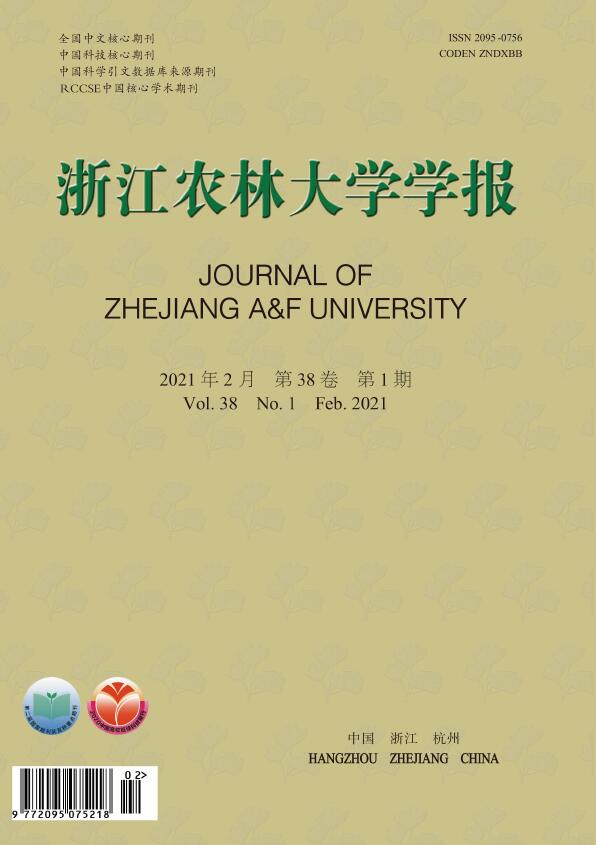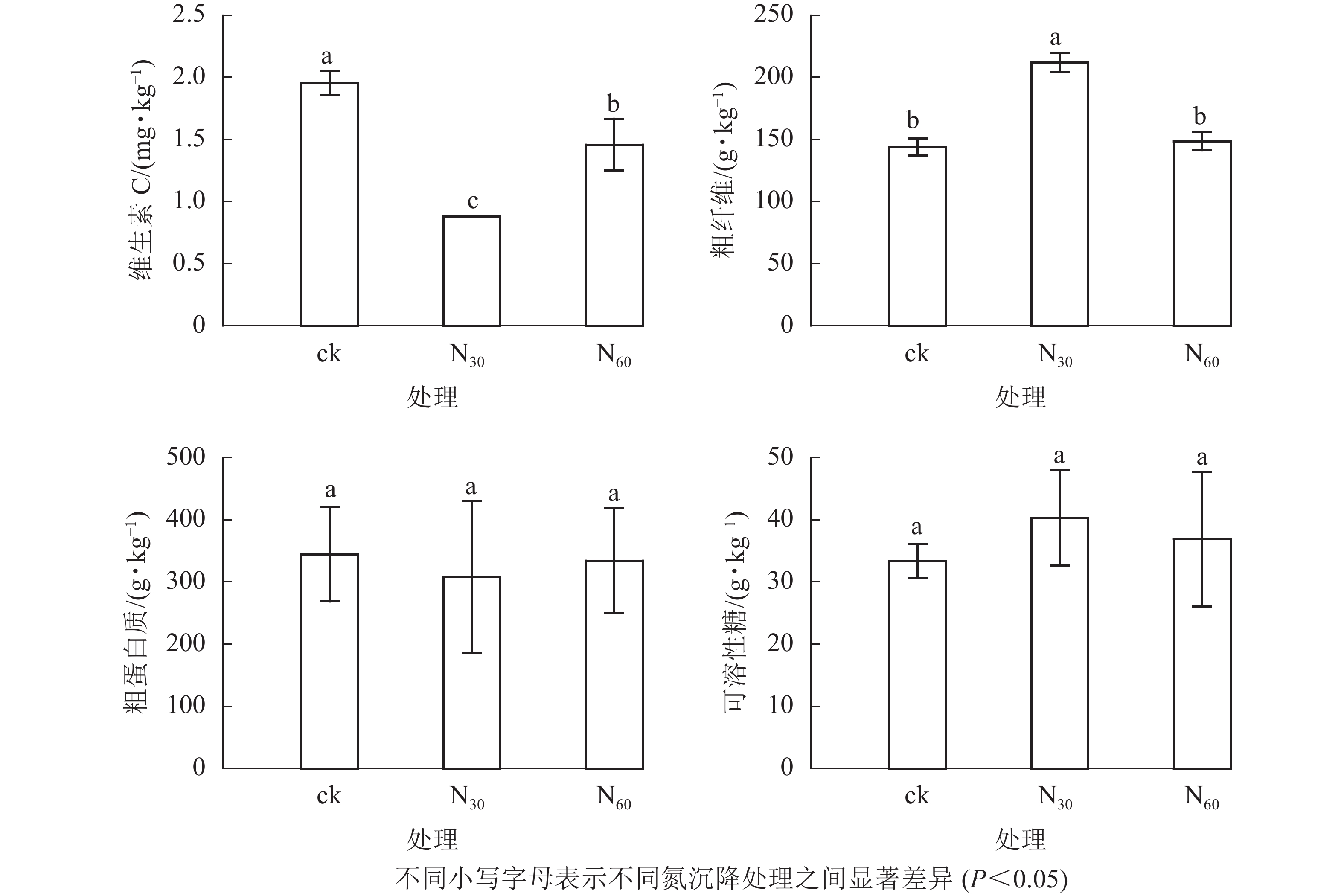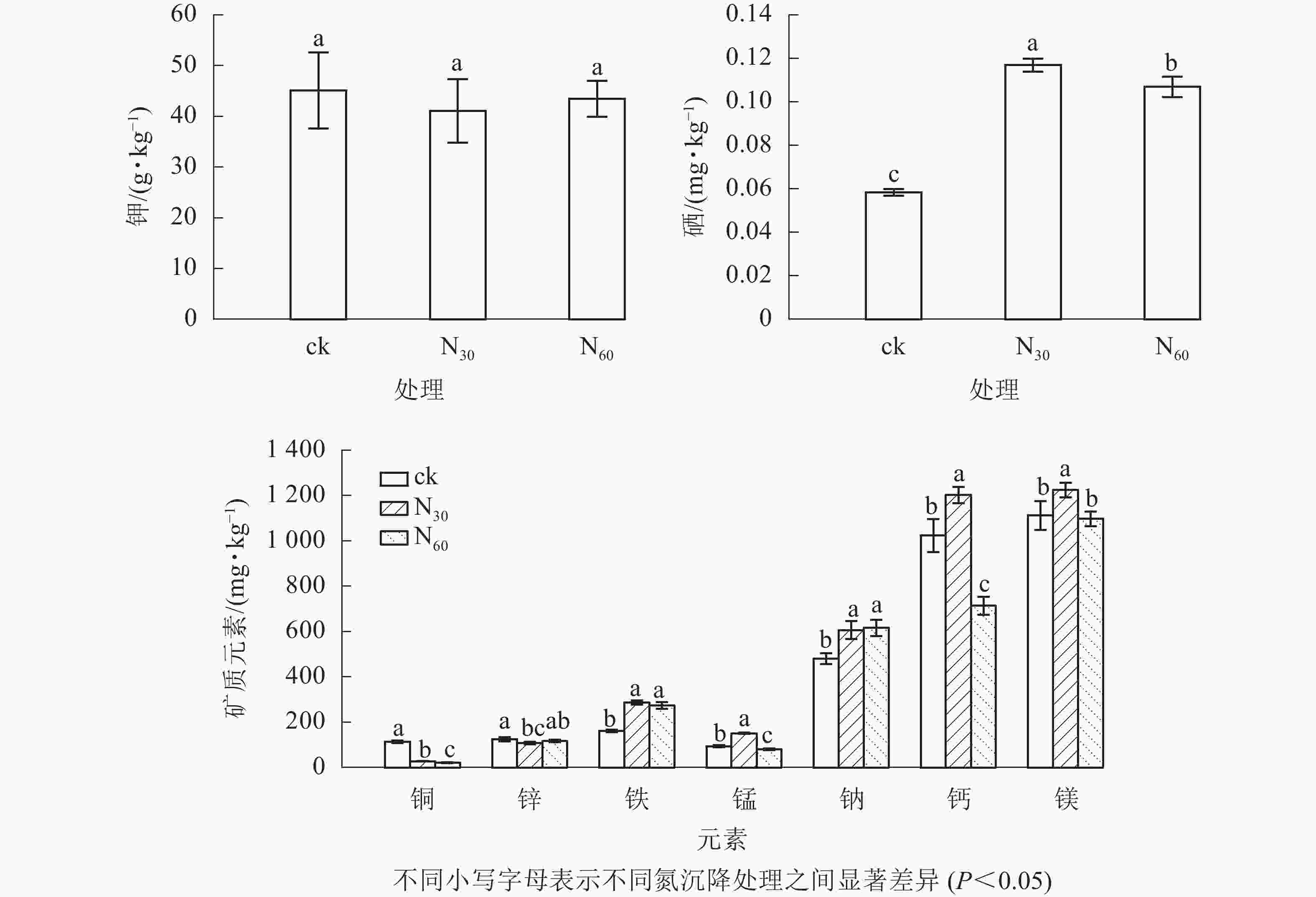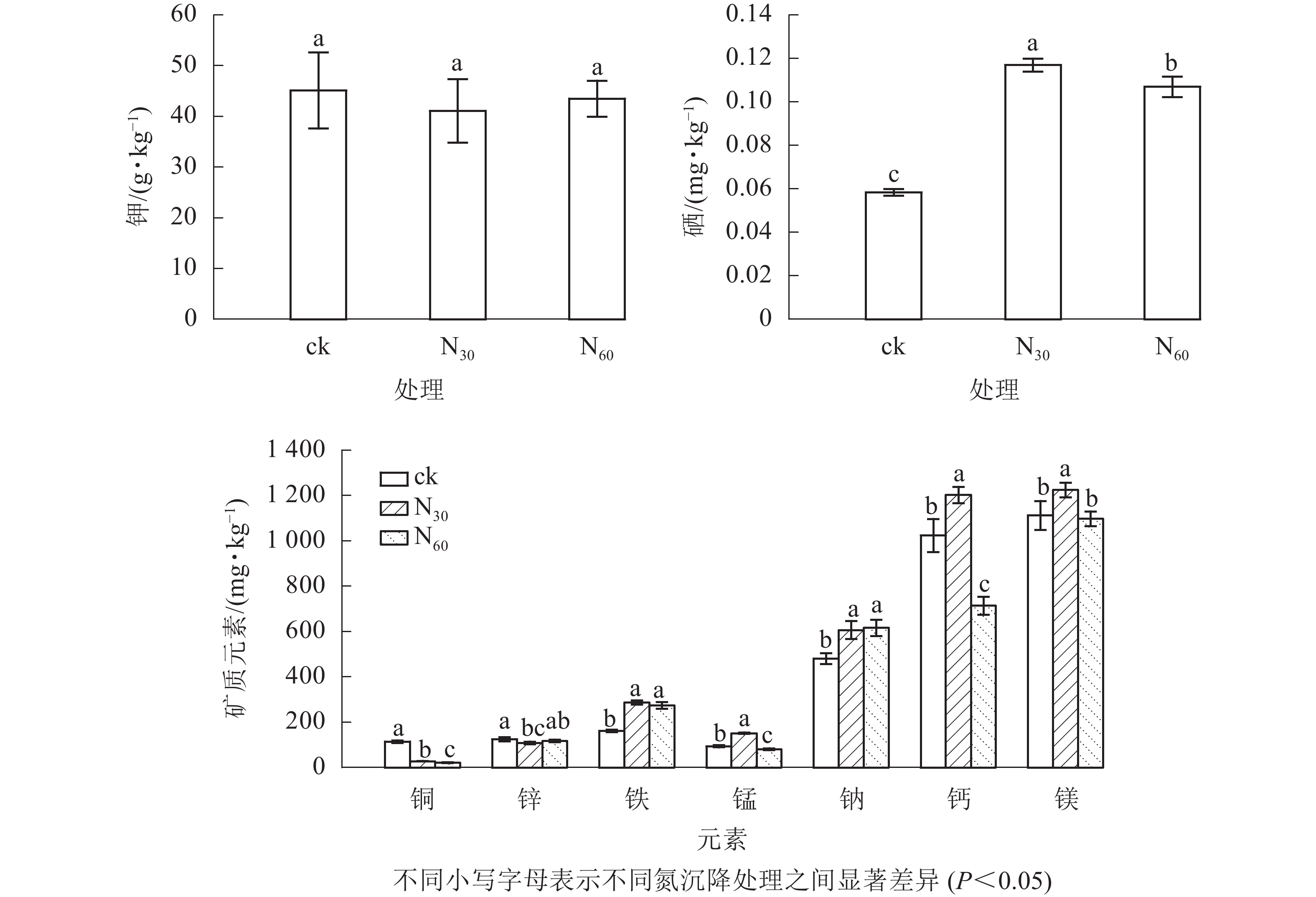-
氨基酸、维生素C、粗纤维、粗蛋白质和可溶性糖是人体不可或缺的营养成分,参与体内重要的生命活动和代谢过程,而矿质元素是组成激素、维生素、蛋白质和多种酶的重要组成部分[1],在人体保健方面起着重要作用。竹笋作为中国的传统佳肴,已有2500多年的食用和栽培历史,其味道鲜美、口感清脆、营养丰富而深受人们喜爱,被誉为最受欢迎的五大保健食品之一。中国是世界上最大的竹笋生产国和消费国,每年有大量的竹笋及其相关产品远销海外。其中,毛竹Phyllostachys edulis笋产量居竹笋产量之首,含蛋白质类、纤维类、糖类、多种矿质元素和氨基酸等人体所需的营养物质,毛竹笋具有高纤维、高氮、高矿质、低脂肪、低糖等营养特点[2-4],符合现代社会人们对饮食健康和食品质量的追求,具有很好的市场前景。目前,竹笋品质的研究主要集中在营养动态[5-6]、存储包装方式[7-8]以及经营措施[9-10]对竹笋营养成分的影响。其中,大量研究表明:施肥能显著影响竹笋的产量[10-11]和笋体中的氨基酸、蛋白质和脂肪等营养物质的含量[9, 12]。近年来,随着工农业生产和人类活动强度的增加,工业活动的密集化,如化石燃料燃烧、氮肥施用、畜禽养殖等人为活动的剧增,致使氮排放量不断攀升,大气中活性氮持续升高,氮沉降已从发达地区迅速发展到全球范围,极大地干扰了氮循环[13]。中国的氮沉降情况愈加严重,仅次于欧洲和美国,为全球第三大氮沉降区[14]。中国亚热带地区的平均氮沉降量已达30.00 kg·hm−2·a−1[15],最大氮沉降量已达51.56 kg·hm−2·a−1,而且还有进一步增加的趋势[16]。中国亚热带地区也是毛竹林的主要分布区,毛竹林面积达443万hm2,约占全国竹林面积的70%,毛竹是该区域重要的森林资源和南方山区农民经济收入的重要来源[17]。目前研究表明:氮沉降对毛竹林的土壤酶活性[18]、毛竹叶片化学计量、养分重吸收及凋落叶养分归还[19]等方面都有显著影响,这些变化是否会影响竹笋营养成分含量,进而改变其品质,尚未可知。为此,本研究以毛竹笋为研究对象,通过人工施氮模拟大气氮沉降的方法,研究氮沉降对毛竹笋品质的影响,以期为在日益增强的大气氮沉降下毛竹笋可持续经营提供新的参考。
HTML
-
研究区位于浙江省杭州市临安区青山湖街道青山笋材两用毛竹林样地(30°14′N,119°42′E),该区处于中亚热带季风气候区的北缘,雨水充足,气候温润,四季分明。年平均降水量1 420 mm,年平均气温15.6 ℃,最高和最低气温分别为41.7 ℃和−13.3 ℃。年均日照约1 847 h,年均无霜期约230 d。土壤类型属于黄土壤,低山丘陵地貌,海拔100~300 m。研究地毛竹林采用集约经营模式,隔年采伐4 a以上的老竹,现存立竹主要是4龄竹(2016年)和2龄竹(2018年)。每年7−8月垦复除去林下的灌木和杂草,9月撒施450 kg·hm−2复合肥,施肥后翻耕30 cm,使之与表层土壤均匀混合。林地的林分和表层土壤(0~20 cm)初始特征见表1[20]。
处理 密度/
(株·hm−2)胸径/
cm土壤密度/
(g·cm−3)土壤有机碳/
(mg·g−1)土壤全氮/
(mg·g−1)土壤全磷/
(mg·g−1)土壤pH 对照(ck) 3 362±309 10.16±0.13 0.97±0.07 23.73±0.24 1.11±0.04 0.52±0.01 4.46±0.01 低氮(N30) 3 408±382 10.31±0.32 0.98±0.04 22.56±1.17 1.17±0.09 0.57±0.05 4.43±0.04 高氮(N60) 3 208±187 10.76±0.59 1.00±0.05 23.15±1.74 1.21±0.12 0.54±0.03 4.48±0.08 说明:数值为均值±标准差 Table 1. Original characteristics of the Ph. edulis plantation and surface soil(0−20 cm)
-
采用典型样方法,在毛竹林内设立9个20 m×20 m典型样地,样地之间设置20 m以上的缓冲间隔区。以中国亚热带地区平均大气氮沉降量(30 kg·hm−2·a−1)和未来增加趋势为依据[21],设置3个氮沉降处理,分别为对照(0 kg·hm−2·a−1,ck)、低氮(30 kg·hm−2·a−1,N30)和高氮(60 kg·hm−2·a−1,N60),各处理重复3次。2013年1月至2019年4月,每月进行模拟氮沉降处理,全年12次。处理方法为在10 L水中加入各样地所需的相应质量的硝酸铵(NH4NO3),采用电动背式喷雾器将配好溶液均匀地喷洒在样地上;对照组采用同样的方法喷洒等质量的水,以减少外加水因素带来的误差影响。
-
于2019年4月在毛竹林样地采挖大小适中,出土高度约3~5 cm的毛竹笋,要求其整体形态特征明显、饱满健壮、笋体完整,每个样地各采集5个春笋,将笋箨上的泥土和杂物清理干净,装入放有冰袋的恒温采集箱,带回实验室用于分析检测。将新鲜春笋去除掉笋壳和竹篼,选取其中可食的鲜嫩部分切成块状,采用四分法取样,在(130±2) ℃的烘箱中杀青10 min后,放入(60±1) ℃干燥机中烘干,粉碎后过60目筛,放入干燥器中保存以供竹笋营养成分测定。
氨基酸采用氨基酸分析仪测定[9];维生素C用稀酸提取,高效液相色谱法测定[22];粗纤维的测定参照国标GB/T 5009.10−2003《植物类食品中粗纤维的测定》,采用酸碱洗涤法;粗蛋白质采用凯氏定氮法测定[23];可溶性糖采用硫酸苯酚法测定[24];矿质元素采用硝酸-高氯酸(HNO3-HClO4)湿法消化法,消化液用火焰原子吸收光谱法测定[25]。
-
采用单因素方差分析(one-way ANOVA)和最小显著差异法(LSD)分析不同氮沉降强度下毛竹笋中氨基酸、维生素C、粗纤维、粗蛋白质、可溶性糖和矿质元素差异;用SPSS 19.0进行统计分析;用Origin 2018作图。所有数据均为平均值±标准差。
1.1. 研究区概况
1.2. 试验设计
1.3. 样品的采集、处理和测定
1.4. 数据处理分析
-
由表2可知:氮沉降对毛竹鲜笋的总氨基酸、必需氨基酸和甜味氨基酸的质量分数均有显著提高作用(P<0.05),分别增加了45.03%~54.08%、33.66%~35.64%和96.50%~106.50%;而毛竹鲜笋的鲜味氨基酸、苦味氨基酸和芳香类氨基酸的质量分数分别在高氮下显著增加了20.43%、15.83%和21.21%(P<0.05),低氮下显著降低63.44%、11.15%和27.27%(P<0.05)。同时,不同氮沉降水平下,毛竹鲜笋的必需、鲜味、甜味、苦味和芳香类氨基酸比例变化较大,氮沉降对毛竹鲜笋中氨基酸比例具有显著影响(P<0.05)。其中甜味氨基酸比例在氮添加下显著增加34.02%~35.54%(P<0.05),而氮沉降对必需氨基酸、鲜味氨基酸、苦味氨基酸和芳香类氨基酸比例均有显著降低作用(P<0.05),分别降低7.84%~11.96%、21.92%~74.80%、24.79%~38.76%和21.30%~49.80%。
氮处理 必需氨基酸 鲜味氨基酸 甜味氨基酸 苦味氨基酸 芳香类氨基酸 总氨基酸 质量分数/
(mg·g−1)比例/% 质量分数/
(mg·g−1)比例/% 质量分数/
(mg·g−1)比例/% 质量分数/
(mg·g−1)比例/% 质量分数/
(mg·g−1)比例/% 质量分数/
(mg·g−1)对照(ck) 4.04±0.16 Bb 22.57 0.93±0.03 Eb 5.20 2.00±0.10 Db 11.17 2.78±0.11 Cb 15.53 1.32±0.02 Eb 7.37 17.90±0.61 Ab 低氮(N30) 5.40±0.21 Ba 20.80 0.34±0.02 Ec 1.31 3.93±0.18 Ca 15.14 2.47±0.14 Dc 9.51 0.96±0.07 Ec 3.70 25.96±1.10 Aa 高氮(N60) 5.48±0.25 Ba 19.87 1.12±0.04 Da 4.06 4.13±0.14 Ca 14.97 3.22±0.35 Ca 11.68 1.60±0.08 Da 5.80 27.58±1.27 Aa 说明:同列不同小写字母表示不同氮沉降水平对各氨基酸影响差异显著(P<0.05),同行不同大写字母表示相同氮沉降水平对各氨基 酸影响差异显著(P<0.05) Table 2. Contents and proportions of different types of amino acids under different nitrogen(N) deposition
-
氮沉降对毛竹笋营养成分的影响显著(图1)。随氮沉降增加,维生素C和粗蛋白质质量分数均先下降而后升高,而粗纤维和可溶性糖质量分数则均呈先升高而下降趋势,且各处理毛竹笋的粗蛋白质、可溶性糖并无显著差异(P>0.05)。毛竹笋维生素C质量分数不同处理间则差异显著(P<0.05),而高氮沉降毛竹笋粗纤维质量分数与对照并无显著差异(P>0.05),且均显著高于低氮沉降处理(P<0.05)。
-
由图2可知:毛竹笋不同矿质元素质量分数差异较大,且对氮沉降的响应不同。其中:钾最高,硒最低。氮沉降对钾和锌无显著影响(P>0.05),但却显著提高了硒(83.15%~100.33%)、铁(69.57%~77.91%)和钠(26.22%~28.16%)(P<0.05)质量分数,显著降低了铜(18.19%~24.72%)(P<0.05)质量分数。同时,锰、钙和镁质量分数在低氮处理下显著增加(P<0.05),在高氮处理下显著降低(P<0.05)。与对照相比,在低氮处理下锰、钙和镁质量分数均显著提高(P<0.05),分别提高61.67%、17.45%和10.08%,而高氮处理下锰和钙质量分数分别降低14.22%、30.32%。
2.1. 毛竹笋氨基酸质量分数
2.2. 毛竹笋营养成分
2.3. 毛竹笋矿质元素质量分数
-
本研究毛竹笋中共检测出18种氨基酸,其中赖氨酸(Lys)、苯丙氨酸(Phe)、蛋氨酸(Met)、苏氨酸(Thr)、异亮氨酸(Ile)、亮氨酸(Leu)和缬氨酸(Val)为人体必需氨基酸。氮沉降显著提高毛竹笋中总氨基酸和必需氨基酸的质量分数,这与施肥[9, 26]和施氮肥[26]的研究效果相同。
环境因素会影响竹笋中总氨基酸质量分数,其中对氨基酸影响最大的因素为氮素供应水平[27]。氮素是植物体内氨同化和氨基酸合成的重要来源,是植物生理生化过程的重要营养物质[28]。土壤中的氮元素增加,为植物体合成氨基酸提供了丰富的氮源[9]。因此,氮沉降增加了毛竹笋中总氨基酸和必需氨基酸的质量分数,能够促进人体氨基酸平衡,减少因氨基酸失衡所造成的代谢紊乱、机体抵抗力下降等问题[29]。此外,氨基酸种类、含量和比例对竹笋中蛋白质种类和含量有一定影响,从而影响竹笋的品质[30]。其中,鲜味氨基酸(天冬氨酸和谷氨酸)和芳香类氨基酸(苯丙氨酸和酪氨酸)[31]质量分数在高氮处理下显著增加,说明过量氮沉降能提高毛竹笋的鲜味,使得竹笋的食用风味更好。苦味氨基酸(缬氨酸、异亮氨基酸、亮氨酸、酪氨酸、苯丙氨酸)[31]质量分数及比例在低氮下显著降低,而甜味氨基酸(甘氨酸、丙氨酸、脯氨酸、丝氨酸)[31]质量分数及比例在氮沉降下显著增加,表明适度的氮沉降有利于降低竹笋的苦涩味,增加甜味,从而提升其口感。
-
维生素C在增强体液免疫和细胞免疫方面具有显著功效,还能用来预防感冒、延缓衰老和防治冠心病等[29];粗纤维是影响竹笋食用口感的重要指标,在改善肠胃功能、降低血糖和胆固醇含量、防治肠癌和高脂血症等方面也具有重要作用[9];蛋白质在竹笋干物质组成中含量较高,同时也是生物体的主要组成部分和人体必需营养物质[32];可溶性总糖是评价竹笋品质的重要指标[33],也是人体能源物质的重要组成部分。
氮增加不仅有利于蔬菜、作物植株的生长发育,而且对提高果实产量、可溶性糖和蛋白质等营养成分、降低硝酸盐积累具有重要作用,从而改善植株的品质[24]。而土壤中氮素供应过高时,在硝化细菌的作用下会转化成硝酸根离子(
${\rm{NO}}_3^{-} $ )被蔬菜、作物等吸收。在植物体内积累过量硝酸盐,会对植物自身生长造成危害或品质下降,人们食用后也会对健康造成潜在的危害[34]。本研究发现:氮沉降促进了粗纤维和可溶性糖的积累,但降低了维生素C的质量分数。氮沉降下竹笋中粗纤维增加,与施肥促进粗纤维积累的研究结果相同[9]。膳食纤维作为“第七类营养素”,具有提高人体耐糖程度,降低胆固醇和刺激肠胃蠕动的作用[35-36]。氮沉降增加膳食纤维有助于改善竹笋品质。施肥促进竹笋中总糖的提高[37],其原因可能是竹子的光合作用因氮增加而增强,从而增加了运往笋体的糖分,使得笋体内的总糖提高[26]。氮沉降使竹笋中维生素C总体下降,但高氮下维生素C较低氮相比呈显著提高。其原因可能是,氮沉降使土壤中铵态氮(
${\rm{NH}}_4^{+} $ -N)、硝态氮(${\rm{NO}}_3^{-} $ -N)离子显著提高,同时也会导致土壤中离子失衡,使得硫酸根离子(${\rm{SO}}_4^{2-} $ )、氯离子(Cl−)、磷酸一氢根离子(${\rm{HPO}}_4^{2-} $ )积累,从而对竹笋维生素C的合成产生了一定的抑制作用,这与部分蔬菜的研究结果一致[38]。而离子浓度过高时,植物细胞离子通道会出现饱和现象,相关离子通道开放比率下降[39]。随着氮沉降水平的提高,土壤中${\rm{SO}}_4^{2-} $ 、Cl−、${\rm{HPO}}_4^{2-} $ 等离子浓度增加可能会使毛竹根系吸收这些离子的通道开放比率下降,从而降低其对竹笋中维生素C的抑制,故高氮下维生素C较低氮显著提高。 -
毛竹笋中这些元素含量之间存在明显差异,且对氮增加的响应不同,而人体中元素的缺乏和过量可导致多种疾病。氮沉降显著提高了硒、铁和钠质量分数,显著降低了铜质量分数;锰、钙和镁质量分数在低氮下增加,在高氮下降低。硒的缺乏会造成克山病和大骨节病,而氮沉降提高毛竹笋中硒质量分数,这使得人们通过食用同等质量毛竹笋摄入的硒更多,降低了患克山病和大骨节病的可能性;铁是造血元素,其含量的提高有助于食用者减少贫血、免疫力低、无力、头痛等问题[40];钠元素缺乏会使人出现恶心、食欲不振、心率加快、肌肉痉挛等反应[40],氮沉降对其含量的提高,有利于人体健康;成人每日可耐受铜的最高摄入量为8.0 mg·d−1[29]。本研究发现:氮沉降显著降低了毛竹笋中铜质量分数,因而可以降低铜过量所引起的黄疸肝炎、肝硬化、肠胃炎、癌症、Wilson病等疾病可能性[40]。氮沉降会影响土壤养分,同时影响土壤中钙离子、镁离子、钠离子和钾离子等盐基离子[41]。竹笋中不同矿质元素的变化可能与此相关,从而影响笋体内矿质元素含量,而元素间存在拮抗作用,所以不同矿质元素变化不同。
3.1. 氮沉降对毛竹笋氨基酸质量分数的影响
3.2. 氮沉降对毛竹笋营养成分的影响
3.3. 氮沉降对毛竹笋矿质元素的影响
-
氮沉降显著增加了毛竹笋中总氨基酸、必需氨基酸、甜味氨基酸、粗纤维、硒、铁和钠的质量分数,显著降低了铜的质量分数,表明氮沉降提高毛竹笋的部分营养成分,可在一定程度上促进毛竹笋口感和营养品质的改善,有利于人体保健。



















 DownLoad:
DownLoad:
